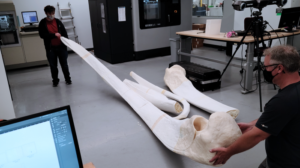Osteology is the study of bones, and few applications of this study are more prominent to the general public than the life-sized display of animal skeletons. If we’re lucky, we might visit a museum display to see a real-life dinosaur skeleton, or that of some other awe-inspiring creature. And, while paleoanthropology is a fascinating look into biological history, there’s something to be said for learning about how currently living creatures are built, too.
Yet, finding complete intact skeletons isn’t always possible. This is where Salt Spring Island-based Cetacea Contracting, which specializes in building and replicating marine mammal skeletons, comes in. They’ve recently partnered with Camosun Innovates, which is using high-tech solutions to greatly decrease the time, labour, and cost associated with creating believably lifelike bones from scratch, to work together to create replicas of whale skeletons.

Traditionally, a missing bone would have to be cast using an existing bone from a similarly sized whale skeleton as a reference, which would be replicated using a silicone mould and plastic. If a donor bone can’t be found, the technicians have to arduously create a model by hand out of foam.
Camosun Innovates is using a combination of 3D scanning and printing to quickly and accurately replicate bones up to 14 feet in length. Camosun Innovates applied research technologist Matt Zeleny says his team is able to use this technology to create a thin outer layer of the bone that is highly realistic and much more economical.
“We actually developed a process where we’re able to make it just like a skin of the overall bone, which can then be filled with foam and glued together, and it results in a solid filled bone for a fraction of the cost,” says Zeleny.
The captures are taken using a handheld spherical scanning gun with reference points tracked by a tripod-mounted stereoscopic camera. The scanner itself uses a grid of bisecting laser lines to capture detail in extremely high resolutions. Zeleny says this method allows for donor bones to be used that are not exactly the right size or shape, since 3D modelling software can also be used to manipulate the scanned reference bone. For example, they could straighten out a curve in a vertebra to better match the target shape, flip a left-handed fin to the other side, or scale the bone to be larger or smaller. Zeleny also says that the use of digital data makes planning the presentation of the skeletons easier than ever.
“We have scans of every bone on the skeleton, and we’re able to pose it virtually inside a model of the location it will be articulated in,” he says. “Historically, they’ve had to lash bones together onto somewhat of an armature and build that as they were figuring out how to pose it, but you can see for some of these animals where the skull may weigh 1,200 pounds, that can be pretty difficult to do, whereas with this digital method, it’s all completely weightless and instantaneous.”
Moving forward, Zeleny believes this technology could be used to heighten the level of interactivity in education.
“You could actually start exposing more people to things they wouldn’t be able to see outside of a museum. For example, if we were to 3D scan the skeleton of a dodo bird, we’d be able to then articulate that, and since it’s something you can reproduce, you can actually let kids have their hands on it; you’re not going to risk breaking it or losing it,” he says. “It’s something where you can create replicas to allow different experiences beyond physical capabilities.”
